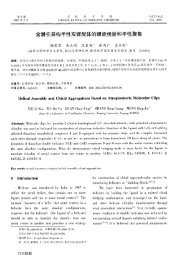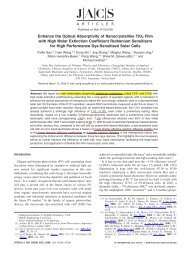Hydrothermal Synthesis of Phosphate-Functionalized Carbon ...
Hydrothermal Synthesis of Phosphate-Functionalized Carbon ...
Hydrothermal Synthesis of Phosphate-Functionalized Carbon ...
You also want an ePaper? Increase the reach of your titles
YUMPU automatically turns print PDFs into web optimized ePapers that Google loves.
ACS Applied Materials & InterfacesFigure 5. (a) Nitrogen adsorption−desorption isotherms and (b)pore-size distributions <strong>of</strong> the C0HC-700 and C2HC-700 samples.originated from fructose in the hydrothermal process canassemble in situ. The phosphate-functionalized CNT-containingcarbon composites termed as CxHC-T were obtained byheating the precursor CxHC at different temperatures.Figure 1 shows the typical FE-SEM and TEM images <strong>of</strong> aseries <strong>of</strong> carbon composites containing different amounts <strong>of</strong>CNTs. In the sample without CNTs, amorphous bulk carbonparticles can be clearly seen, as shown in Figure 1a. For thecarbon composites with CNTs, as shown in Figure 1b-d, CNTsare well-dispersed in the carbon matrix, and no obviousdifferences are observed though the CNT content varies in thecomposites. Further TEM examination (see Figure 1e, f)reveals that the wormlike disordered mesopores with adiameter <strong>of</strong> 3−5 nm are present in the C0HC-700 andC2HC-700 samples, where CNTs are uniformly embedded inthe mesoporous carbon matrix (Figure 1f and Figure S3 in theSupporting Information). It is believed that the wormholemesopores are formed because <strong>of</strong> the self-assembly interactionbetween P123 micelles and carbonaceous sol intermediatesgenerated in the hydrothermal step followed by heat treatment.The uniform dispersion <strong>of</strong> CNTs in the carbon matrix is due tothe hydrophobic−hydrophobic interaction between P123 andCNTs that results in the uniform dispersion <strong>of</strong> CNTs in waterunder ultrasonic treatment (see Figure S1 in the SupportingInformation). The actual content <strong>of</strong> CNTs in the carboncomposites was obtained by thermogravimetric analysis, theresults <strong>of</strong> which are shown in Figure 2 and Table S1 in theSupporting Information. The calculated content <strong>of</strong> CNTs inthe C0HC-700, C1HC-700, C2HC-700, and C3HC-700Research Articlesamples is 0, 1.3, 9.3, and 15.3%, respectively. With increasingthe content <strong>of</strong> CNTs, the electrical conductivity <strong>of</strong> the carboncomposites also increases because <strong>of</strong> the high conductivity <strong>of</strong>CNTs, and the results are shown in Table 1.The FTIR microspectroscopy study confirms that thephosphate groups are present in the composites, as can beseen in Figure 3. The spectrum shows typical characteristic <strong>of</strong>phosphocarbonaceous compounds present in the carbonsmaterials activated by phosphoric acid. The peak at 1160cm −1 is due to the stretching vibration <strong>of</strong> hydrogen-bondedPO groups and the O−C stretching vibration in the P−O−C aromatic linkage, and the peak at 1062 cm −1 is assigned to thesymmetrical vibration in polyphosphate chain P−O−P. 21 TheXPS spectra <strong>of</strong> the C2HC-700 sample were also collected t<strong>of</strong>urther analyze the surface chemistry properties <strong>of</strong> the carboncomposite. The spectrum in Figure 4a indicates the presence <strong>of</strong>phosphorus species in the composite and the phosphoruscontent is 2.5 at%. High-resolution XPS spectrum <strong>of</strong> P2p peakcan be deconvoluted into the peak with a binding energy at133.2 eV, which can be identified as the phosphorus species astetra-coordinated phosphorus(V) (Table 2). 22,23 The spectra <strong>of</strong>C1s peak and O1s peak can be deconvoluted into sixcomponents and four components, respectively, and the resultswere summarized in Table 2. The carbon species correspond tocarbide carbon (283.9 eV); graphite carbon (284.6 eV); carbonin alcohol, ether groups, and/or C−O−P linkage (285.4 eV);carbon in carbonyl groups (286.5 eV); carboxyl and/or estergroups (288.9 eV); and π−π* transitions in aromatic rings(291.2 eV). 22 The oxygen species represent quinones (530.3eV); oxygen double-bonded to carbon (CO) and nonbridgingoxygen in the phosphate groups (PO) (531.6 eV);oxygen single-bonded to carbon in C−O and in C−O−Pgroups (532.6 eV); and oxygen single bonds in hydroxyl groups(533.6 eV). 22,24The porosity <strong>of</strong> the as-made carbon materials was analyzedby N 2 adsorption technique. Figure 5a is the isotherms <strong>of</strong> theC0HC-700 and C2HC-700 samples, showing a combinedcharacteristic <strong>of</strong> type I/IV isotherms. For the C0HC-700sample, its BET surface area is 392 m 2 g −1 . For the C2HC-700sample, its BET surface area is 587 m 2 g −1 . The pore sizedistribution <strong>of</strong> the C2HC-700 sample shows a similarhierarchical porous structure in comparison to C0HC-700 inthe region <strong>of</strong> 0.5 to 10 nm, <strong>of</strong> which the difference is thatC2HC-700 contains more larger mesopores (20−50 nm) andmacropores (50−200 nm), as shown in Figure 5b. The averagemicropore size <strong>of</strong> C0HC-700 is 0.54 nm, which is smaller than0.59 nm <strong>of</strong> C2HC-700. The formation <strong>of</strong> micropores ispossibly due to the activation by H 3 PO 4 in the post heattreatment step. Besides, the mesopores in the C0HC-700 andC2HC-700 samples formed by the s<strong>of</strong>t template P123 are 4.4and 5.2 nm, respectively, and this is consistent with the TEMresults (Figure 1e, f). This will demonstrate that the hierarchicalpore structures have been formed in the composites.Interestingly, the large mesopores and macropores in theC2HC-700 sample are due to the presence <strong>of</strong> CNTs (seeFigure S2 in the Supporting Information), which can functionas a fast ion-transport pathway that further improve the ratecapability <strong>of</strong> the supercapacitors. 7To evaluate the effect <strong>of</strong> CNT on the electrochemicalperformance <strong>of</strong> the CxHC-700 samples, cyclic voltammetry,galvanostatic charge−discharge, and electrochemical impedancespectroscopy (EIS) were recorded in 6 M KOH aqueoussolution in a three-electrode cell. Figure 6a, b show the cyclic2107dx.doi.org/10.1021/am303052n | ACS Appl. Mater. Interfaces 2013, 5, 2104−2110
















